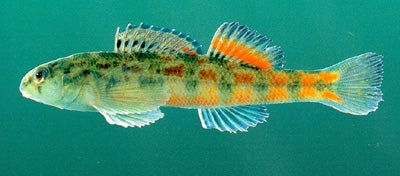SCIENTIFIC NAME: Etheostoma ramseyi
CHARACTERISTICS: Breeding males of Etheostoma ramseyi have orange along the lower sides and caudal peduncle, extending dorsally to the bottom of brown lateral blotches that are sporadically overlaid with green. A series of distinct, oblong blotches occurs on the upper sides, just above the lateral line and between the diagonal brownish green bars. The blotches are bright red or red-orange near the caudal base to russet anteriorly. Breast, gill membranes, lower gill covers, cheeks, and lower snout are light to dark turquoise. See Suttkus et al. (1994) for original description.
ADULT SIZE: 1.4 to 2 in (35 to 50 mm)
DISTRIBUTION: The Alabama darter is distributed below the Fall Line in the Alabama River drainage and above the Fall Line throughout the Cahaba River system to its headwaters. Absence of this species in tributaries upstream of the Autauga Creek system is perhaps related to the large areal extent of the Black Belt in this region. The Alabama darter is replaced in the Coosa River system by the Coosa darter, E. coosae, and in the Tallapoosa River system by the Tallapoosa darter, E. tallapoosae.
HABITAT AND BIOLOGY: Etheostoma ramseyi occurs in a variety of habitats, from small stream pools with sand and gravel substrates to stream riffles containing sand, gravel, clay, rubble, bedrock, and cobble. The occurrence of structure - cobble, rubble, broken bedrock, or log snags - is a prerequisite for finding this species in numbers. Spawning occurs from early March to late April or May at temperatures less than 68ºF (20ºC) (Suttkus, Bailey, and Bart, 1994).
REMARKS: The type locality of the Alabama darter is Beaver Creek near Sunny South, Wilcox County, Alabama.
ORIGINAL DESCRIPTION: Suttkus and Bailey described the Alabama darter in 1994.
ETYMOLOGY:
Etheostoma means strain mouth, possibly referring to the small mouth.
Ramseyi means in honor of John S. Ramsey, formerly of Auburn University, who contributed extensively to knowledge of Alabama’s fishes.
The copyrighted information above is from Fishes of Alabama and the Mobile Basin.






